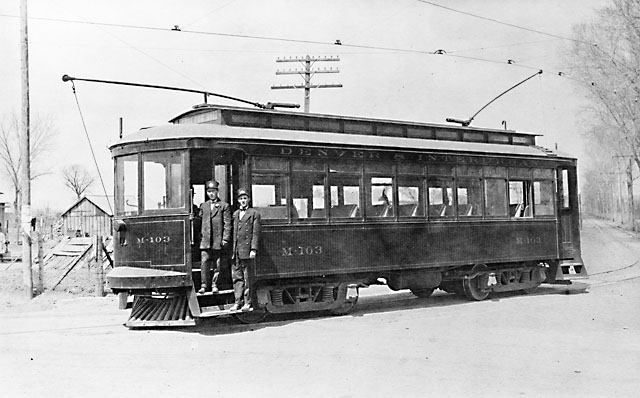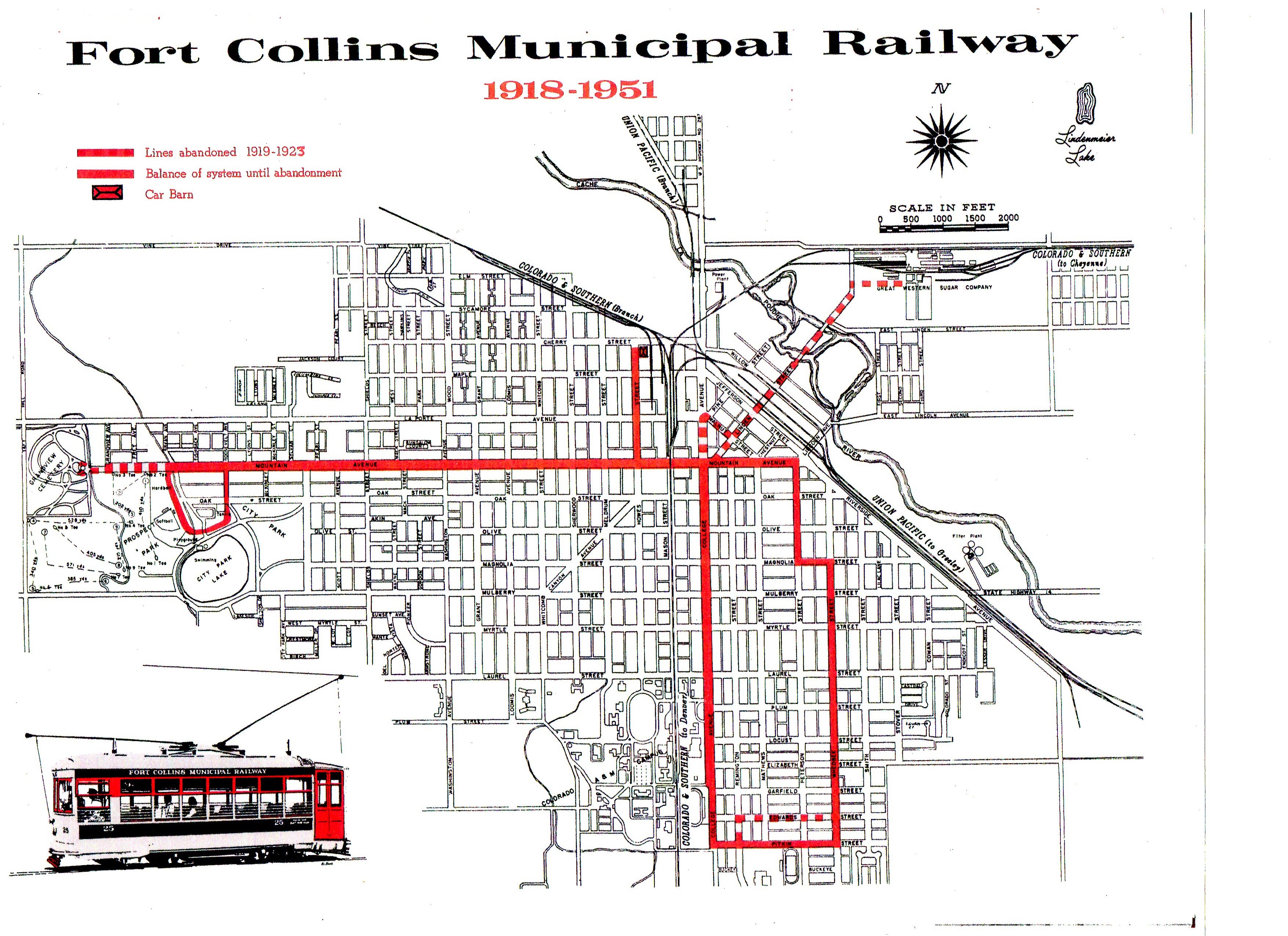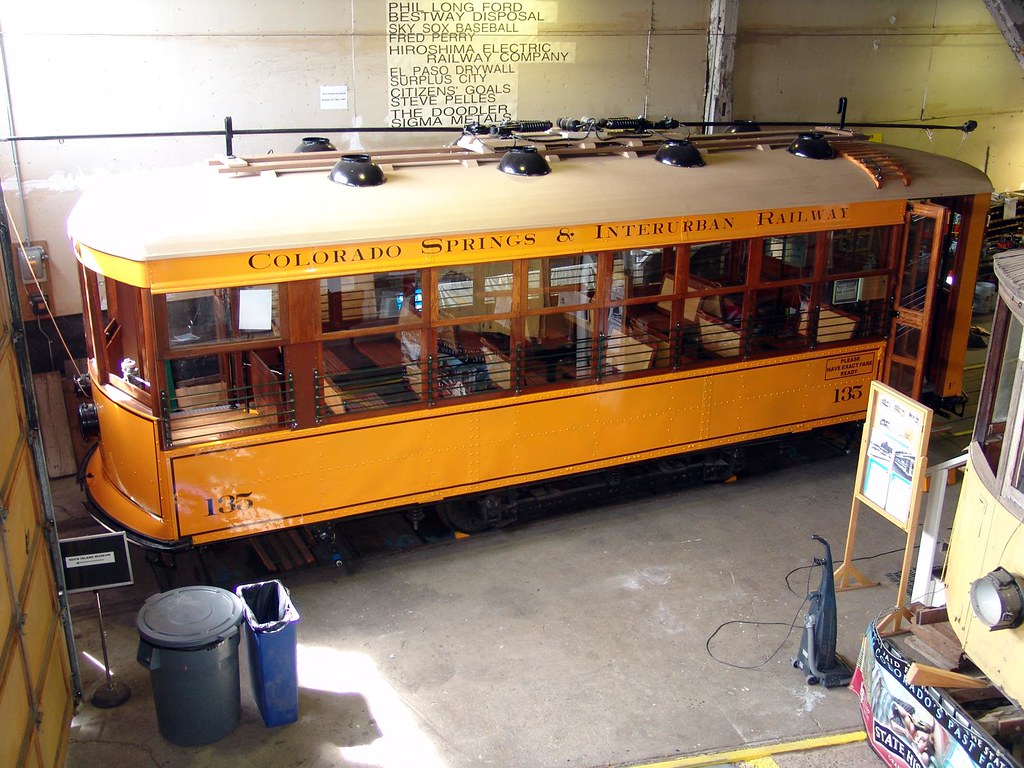-----
 |
| A steam traction engine in Fort Collins, 1915, grading Mason Street (Fort Collins Images) |
The Colorado & Southern Railroad (C&S) first brought electric streetcars to Fort Collins on July 9, 1907, when the Fort Collins Express newspaper reported that a large steam traction engine was busy tearing up West Mountain Avenue to lay down new street track. During the five months of construction, C&S assigned one of their steam locomotives and a few passenger cars to test and operate the new line. Five months later, just shy of New Years Eve, 1907, the Denver & Interurban (D&I) Company's Fort Collins division opened nine miles of electrified downtown track to the general public.
 |
| Newly-built Woeber Woodie D&I No. M103 just after opening, 1909 (Fort Collins images) |
Working the system were four wood-bodied streetcars manufactured nearby at the Woeber Car and Carriage Company, the only streetcar manufacturer in Colorado. They were 39 feet long, developed 160HP over four motors, could seat forty, and ran off a 500-volt trolley wire. At the time system opened, Fort Collins registered around 50 automobiles in town. After two years of streetcar operation, that number ballooned to 140. To meet what they saw as growing ridership, D&I invested in two more cars from the Jewett Car Company, but this would be the last private action made by the company.
 |
| All four Woeber cars meet at the "grand junction" intersection on College and Mountain. The line to the upper left is the College Ave/Walnut St loop. (Fort Collins Images) |
As stated before, the C&S came under the control of the Chicago, Burlington, and Quincy Railroad (CB&Q) at the end of 1908, and C&S's original plan to have their famous "Kite Route" interurban connect Boulder to Fort Collins was scuttled. Fort Collins continued to have their streetcar operated under the CB&Q, but light ridership meant that operating as a private venture was uneconomical. D&I tried everything to save money, such as converting the Woeber and Jewetts to one-man operation, but this did nothing to satisfy their financial woes. The Fort Collins Railway struggled for a decade before abruptly ceasing operation on the night of July 10, 1918, after going into receivership.
 |
| One of the Jewett-built D&I cars at Linden and Mountain, 1913 (Fort Collins Images) |
With faith still in their public transit, and with much of the town now having paved roads, the citizens of Fort Collins proposed to make their system a municipal venture, following in the footsteps of cities like San Francisco. The city council approved, and in January 1919, the citizens voted to charter the Fort Collins Municipal Railway (FCMR). The six Woeber and Jewett cars were not part of the new charter, and unfortunately they were also too big (at forty passengers a car) to operate in such a small town (at the time), so all six were retired and sold for scrap.
 |
| Fort Collins 24 and 25 (along with an unidentified car) all crowd around the "grand junction" on Mountain and College Avenues, 1948. (Fort Collins History Connection) |
The FCMR would instead order four new streetcars from the American Car Company, which they saw as small enough for the town's needs. These would be the Birney Safety Cars, so-named because they could be safely operated by one person and the new "deadman" control ensured no runaways, and four would arrive in town on May 24, 1919. Cars 20-23 would immediately set to work on the nine mile loop-and-stub system, with services now cut back to a loop through Prospect Park, a larger loop south around College Avenue, Pitkin, Whedbee, and Peterson Streets, and the deletion of the Linden Street line to the Great Western Sugar Factory.
 |
| The new Ft. Collins system map, beginning in 1918. Mountain Ave. would eventually be double-tracked with a passing siding. (HistoryColorado.org) |
As automobile ownership boomed in the 1920s and saw many electric railways fall by the wayside, the Ft. Collins system maintained a pristine level of service with such a small roster and route. All of the five-to-seven Birneys that made up the system ran on 20 minute intervals on the newly-restored system, and ridership was so great that the FCMR invested in three more Birneys in 1924: No. 24, from the Cincinnati Car Company (famous for the Peter Witt streetcar), and Nos. 25 and 26 from the defunct Cheyenne Electric Railway Company. (An additional No. 24 was purchased from the Virginia Railway and Power Co, but used as spares for No. 25.) As many electric companies after the 1920s would heavily depend on modern PCC streetcars and retire the Birney cars, this left Fort Collins as the last electric railroad to operate them exclusively.
 |
| Birney 26 meets an unidentified car on College, Mountain, and Linden Street, 1937 (Fort Collins History Connection) |
By 1951, after its competitors in Denver, Pueblo, and Golden all ended streetcar service, Fort Collins decided to hang up its own hat and end their little streetcar system. Up until that point, the city was losing money hand-over-fist to keep their public transit operating over the last several months. Street railway operations ended on June 30, 1951, making the Fort Collins system the last and longest-lived streetcar to operate in the state of Colorado.
 |
| An old crane truck is called over to help remove rails along Mountain Avenue in 1977. (Fort Collins History Connection) |
Five of the Birneys would find new lives in preservation. Birney 20 would be preserved at the Prairie Pioneer Village in Minden, Nebraska, where it remains to this day. Birney 22 was sold to the Rocky Mountain Railroad Club in 1952, and would be displayed at the Colorado Railroad Museum until 1997, when it was leased by the Colorado Springs Transportation Society and restored as CS&I 135. Birneys 23, 24 (the first one), and 25 would be scrapped prior to abandonment. The last, Birney 26, would find its new home at the Henry Ford Museum in 1953, being statically preserved as the only surviving Cheyenne Electric Railway car. Birney 21 would be the only car to remain in Fort Collins, finding a new home in the Pioneer Museum (now the Fort Collins Museum) on static display until 1977. What happens after? Did I fudge my math purposefully and only list four cars? Find out next week!
 |
| Fort Collins No. 20 in Minden, Nebraska's Pioneer Village (Real: The Kitchen and Beyond) |
 |
| CS&I 135 (ex-Fort Collins No. 22) at Colorado Springs with the Pike's Peak Historical Street Railway Foundation (History Colorado) |
 |
| Fort Collins No. 26 (ex-Cheyenne Electric Railway 7) at the Henry Ford (The Henry Ford) |
-----

No comments:
Post a Comment